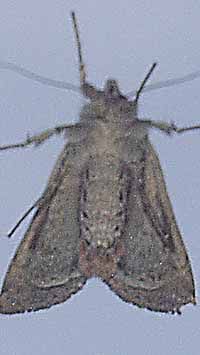| Dark colored moths continue to plague the county. The flying insects are the adult form of the army cutworm that invaded agricultural lands in the local area in early spring. |
Early in the spring, people attending the Region 8 track meet at Carbon High were complaining about the number of worms being smashed on the track by runners as athletes competed at the facility.
At that time, few residents outside of the agricultural community seemed concerned, other than about the mess the creatures were making.
But farmers in the Carbon County area knew producers had a lot to worry about. Cutworms do exactly what the name describes – the insects cut plants off.
At the time, all alfalfa in the county could have been decimated by the insects. However due to timing and growth, the damage did not materialize as expected. But some farmers in the Castle Valley area did lose crops to the insects.
Given the biology of the insects, it was just a matter of time before the worms would turn from the larval stage into the adult stage of the life cycle, according to the experts.
The adult stage finds the insect turning into a dark colored moth that flits around and is mostly a nuisance rather than a danger to people or plants.
“Right now, they are building up their energy by taking nectar from flowering plants,” explained Carbon’s Utah State University Extension agent, Marlon Winger.
“Within two or three weeks, they will be flying to a higher altitude for most of the summer. A few will remain, but most will be gone,” continued the Carbon Extension agent.
However, the complacency of most local residents to the damage the cutworms caused in agriculture has turned into concern.
Public agencies, radio stations and the Sun Advocate have been deluged with calls from citizens regarding the volumes of moths appearing in the county.
“We have been overwhelmed with calls about the problem,” stated Winger. “Really, all we can do is wait this out. They don’t do any damage at this stage other than to be a real nuisance.”
Local residents have been reporting various kinds of problems caused by the moths, from being distracted by the insects while driving to messes on window sills and various items from the droppings.
The infestation also varies from place to place in the county.
Residents of Helper report few of the insects while people living in Carbonville and Price have encountered heavy infestations. Yet, the numbers are spotty.
Andalex workers report large numbers of the moths at the mine above the Carbon airport. The Hunter power plant in Castle Dale has also had a large number of the insects. But at other locations in Castle Valley, the insects are light or non-existent.
One traveler from Vernal recently reported that the moths are thick in Uintah County as well.
As the moths fly to higher altitudes, Winger pointed out that many will die due to life cycle longevity and because wildlife species like to eat the insects.
“These moths are very lethargic and it is easy for many animals to catch them,” noted the USU Extension agent. “Bears particularly like to eat these bugs.”
Cutworms are nocturnal and the moths tend to act in the same manner.
However, with the large numbers of the flying insects appearing suddenly, the moths are also plaguing residents during the day.
While the moths are prevalent at most locations in the lower areas of the county, places with trees and growth tend to have heavier concentrations.
Many residents have also complained about the insects invading houses, sheds and garages in large numbers.
At night, the moths tend to find warmer places to hide, like under eaves and in buildings with cracks.
Like June bugs, the moths are also attracted to electric lights.
The flying insects also seem to like the inside of motor vehicles.
Many local residents have been surprised to find out how many so-called “holes” are in cars and pickup trucks when they discover the interior of locked vehicles filled with the insects.
“Their numbers will be reduced, but they will return to these lower altitudes in late August to lay their eggs,” explained Winger. “That will begin the life cycle for them all over again for next year.”
The insects’ eggs are laid on grass and weed stems or behind the leaf sheath of the plants.
In the Carbon County area, it is generally accepted by most experts that the insects will have one generation per year, including the larva, pupa and adult stages.
Army cutworms are present every year, but the insects are most prolific in years with dry summers and wet autumns.
“The drought and weather have a lot do to do with cutworm populations,” explained Winger. “As we have looked back in data and information, the last time we can find any kind of invasion like this in our area was in Ferron in 1896. They let the kids out of school in the spring and gave them scissors to go out into the field to find the caterpillars and cut them in half to destroy them.”
Winger says the way the growth of plants came this year and the cutworms came in, they may have eaten as many weeds as they did alfalfa and grain.
Many residents have asked about spraying the insects, or even having officials do some kind of spraying campaign. But Winger says at this point that would be almost useless because of the way they can move around.
“You could spray, but you would only kill a few and there would be 49 times as many that would still live,” he stated. “It’s just a matter of time and they will be gone until later in the summer.”
For those who want to know more about Army Cutworms, a fact sheet is on the Utah State University extension web page at http://extension.usu.edu/public/newpub2.htm.

